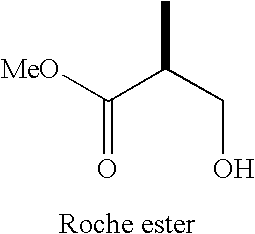Intermediates for the synthesis of polypropionate antibiotics
a polypropionate antibiotic and intermediate technology, applied in the field of discodermolide, can solve the problems of commercially meaningful quantities of drugs and the formidable task of synthesis
- Summary
- Abstract
- Description
- Claims
- Application Information
AI Technical Summary
Benefits of technology
Problems solved by technology
Method used
Image
Examples
example 1
Racemic Cis Allylic Alcohol (3)
[0076]A solution of cyclohexanecarboxaldehyde (2) (2.33 g, 20.8 mmol) in 40 mL of THF was cooled to −40° C. 1-Propynylmagnesium bromide (0.5 M in THF, 50.0 mL was added dropwise. After adding, the temperature of the reaction mixture was increased to 0° C. and stirred for 2 h. The reaction was quenched with saturated aqueous ammonium chloride solution. The water phase was extracted with ether (3×20 mL). The combined organic layers were washed with brine, dried over MgSO4, filtered, and concentrated. The crude product was chromatographed (HE: EA=10:1) to provide 2.78 g (88%) of the propargyl alcohol as an oil. 1H NMR (300 MHz, CDCl3) 4.10 (m, 1H), 1.85 (d, J=2.1 Hz, 3H), 1.80-1.65 (m, 5H), 1.58-1.20 (m, 1H), 1.30-0.98 (m, 6H); 13C NMR (300 MHz, CDCl3) 81.6, 79.5, 67.5, 44.4, 28.7, 28.2, 26.5, 26.02, 26.00, 3.7.
[0077]A solution of the propargyl alcohol from the above experiment (380 mg, 2.5 mmol) in hexane (3 mL) was treated with Pd / CaCO3 poisoned with Pb...
example 2
Racemic Ether (4)
[0078]A 100-mL reaction flask was charged with 95% sodium hydride (2.76 g, 109 mmol) and 20 mL of dry THF. Racemic alcohol 3 (2.40 g, 15.6 mmol) in 2 mL of THF was added dropwise followed by 3-chloro-2-methylpropene (4.24 g, 46.8 mmol). The reaction mixture was stirred at reflux overnight and then cooled to room temperature. Excess sodium hydride was quenched by the slow addition of 3 mL of water. The resulting mixture was poured into water. Ether extracts (30 mL×3) were combined and the resulting organic solution was dried over MgSO4, filtered, and concentrated. Chromatography (HE: EA=30:1) produced a colorless oil (2.78 g, 85%). 1H NMR (300 MHz, CDCl3) 5.73 (dqd, J=10.2, 6.8, 1.3 Hz, 1H), 5.24 (ddq, 10.2, 9.4, 1.8 Hz, 1H), 4.93 (m, 1H), 4.85 (m, 1H), 3.90 (d, J=12.6 Hz, 1H), 3.80 (m, 1H), 3.69 (d, J=12.4 Hz, 1H), 1.96 (m, 1H), 1.73 (s, 3H), 1.70-1.65 (m, 5H), 1.62 (dd, J=7.1, 2.0 Hz, 3H), 1.58-0.80 (m, 6H); 13C NMR (300 MHz, CDCl3) 143.3, 130.9, 128.1, 112.1, 77.9...
example 3
Racemic Dienol (5)
[0079]Potassium tert-butoxide (1.0 M in THF, 5.5 mL, 5.5 mmol) was added to a flask under argon and an additional 5.0 mL of THF was added. The solution was cooled to −78° C. and ether (4) (5.0 mmol, 1.05 g) was added. n-Butyllithium (1.6M in THF, 3.8 mL, 6.1 mmol) was slowly added. The mixture was warmed to −20° C. over 4 h and the stirred 12 h at −20° C. and 2 h at 0° C. The reaction was quenched with water and the resulting mixture was extracted with ether. The organic phase was dried over MgSO4 and concentrated. Chromatography (HE: EA=10:1) gave a colorless oil (819 mg, 78%). 1H NMR (300 MHz, CDCl3) 5.40 (dd, J=16.2, 6.6 Hz, 1H), 5.31 (dd, J=16.2, 6.6 Hz, 1H), 4.92 (m, 1H), 4.86 (m, 1H), 3.87 (d, J=20.0 Hz, 1H), 2.33 (m, 1H), 1.90 (m, 1H), 1.69 (s, 3H), 1.68-1.65 (m, 5H), 1.32-1.05 (m, 6H), 0.97 (d, J=6.9 Hz, 3H); 13C NMR (300 MHz, CDCl3) 146.2, 137.4, 129.9, 112.1, 79.3, 41.0, 40.1, 33.5, 33.4, 26.5, 26.4, 18.9, 14.8. IR 3403 (broad), 2965, 2924, 2851, 1448, 97...
PUM
 Login to View More
Login to View More Abstract
Description
Claims
Application Information
 Login to View More
Login to View More - R&D
- Intellectual Property
- Life Sciences
- Materials
- Tech Scout
- Unparalleled Data Quality
- Higher Quality Content
- 60% Fewer Hallucinations
Browse by: Latest US Patents, China's latest patents, Technical Efficacy Thesaurus, Application Domain, Technology Topic, Popular Technical Reports.
© 2025 PatSnap. All rights reserved.Legal|Privacy policy|Modern Slavery Act Transparency Statement|Sitemap|About US| Contact US: help@patsnap.com



